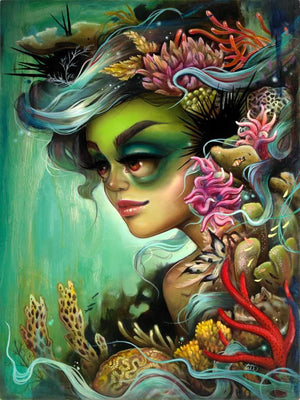
Rainforests of the Sea by Tatiana Suarez
Limited Edition of 50 (signed & numbered)
Fine art Giclée print on Italian cold-press watercolor paper
12" x 16"
Printed by Paragon Press
Species of the month
Corals

Photograph by Wendy Capili Wilkie

Photograph by Wendy Capili Wilkie

Conservation Status
Threatened and at risk of extinction
Coral Reefs are underwater structures forming colonies of tiny living animals (corals) found in marine waters that contain few nutrients. Often called "rainforests of the sea", coral reefs form some of the most diverse ecosystems on Earth. They occupy less than 0.1% of the world's ocean surface, about half the area of France, yet they provide a home for 25% of all marine species.
Typically coral reefs are found in waters less than 150 feet deep so that they are reachable by sunlight. Corals have a symbiotic relationship to microscopic algae called zooxanthellae that provide the coral with food and give them their vibrant colors and grow on average about 1mm to 4cm per year.
Aside from contributing to the formation of sand and beaches, coral reefs are sometimes considered the medicine cabinets of the 21st century. Coral reef plants and animals are important sources of new medicines being developed to treat cancer, arthritis, human bacterial infections, Alzheimer's disease, heart disease, viruses, and other diseases.
Coral reefs also deliver ecosystem services to tourism, fisheries and shoreline protection. The annual global economic value of coral reefs has been estimated at US$ 375 billion. However, coral reefs are fragile ecosystems making them among the most vulnerable ecosystems in the world, partly because they are very sensitive to changes in water temperature.
These corals are under major threat due to climate change, ocean acidification, blast fishing, cyanide fishing for aquarium fish, harvesting for the aquarium trade, overuse of reef resources, and harmful land-use practices, including urban and agricultural runoff and water pollution, which is harmful to reefs by encouraging excess algae growth which in turn smothers the coral.
The increase in water temperatures is causing stress to the coral reefs. When this happens, corals expel the zooxanthellae algae and turn white or bleach. If the algae don't return, the coral dies. Coral bleaching is caused by elevated sea surface temperatures due to global climate change.
General estimates show approximately 10% of the world's coral reefs are dead. About 60% of the world's reefs are at risk due to destructive, human-related activities. The threat to the health of reefs is particularly strong in Southeast Asia, where 80% of reefs are endangered. By the 2030s, 90% of reefs are expected to be at risk from both human activities and climate change by 2050, all coral reefs will be in danger.
You can help save corals
-
Donate to organization working to raise awareness and research such as PangeaSeed, Reef Check, Coral Reef Alliance etc.
-
Advocate global and regional action to protect of coral and coral reefs.
-
Support the establishment and protection of marine protected areas (MPAs).
-
Recommend ecotourism and dive or snorkel on coral reefs - but remember to look and DO NOT touch or stand on corals. This offers sustainable monetary alternatives to destructive fishing methods.
-
Think twice before you buy. Do not support the illegal trade of coral and try to reduce your carbon footprint.
-
Educate yourself, friend and family on the issues facing coral and other endangered ocean animals. Act NOW if we wish to save our seas.
The Story Behind
Rainforests of the Sea
Tatiana Suarez

About the Artist
Tatiana Suarez


